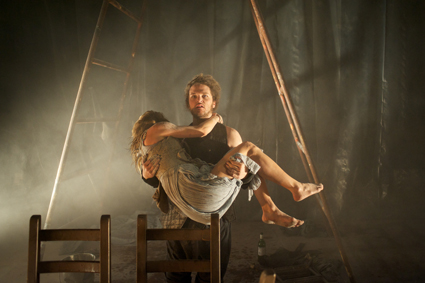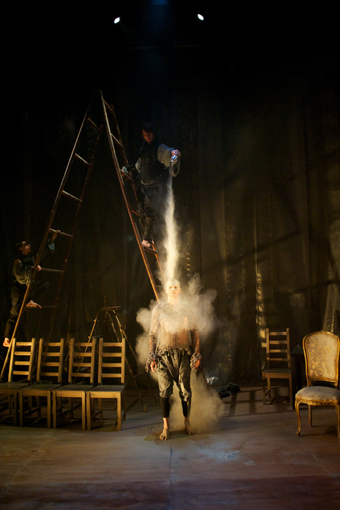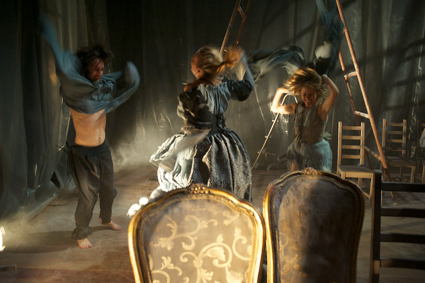the balancing act of life itself
douglas leonard: the danger ensemble, the hamlet apocalypse

Dave Sleswick, Noa Rotem, The Hamlet Apocalypse, The Danger Ensemble
photo Morgan Roberts
Dave Sleswick, Noa Rotem, The Hamlet Apocalypse, The Danger Ensemble
IN THE HAMLET APOCALYPSE, DIRECTOR STEVEN MITCHELL WRIGHT AND DRAMATURG CHRIS BECKEY WITH THE DANGER ENSEMBLE PLAYERS (KATRINA CORNWELL, MARK HILL, ROBBIE O’BRIEN, NOA ROTEM, POLLY SARA, DAVE SLESWICK AND PETA WARD) AND THE CRUCIAL ASSISTANCE OF SOUND AND LIGHT CREATIVES DANE ALEXANDER AND BEN HUGHES HAVE PRODUCED A TOUR DE FORCE OF RAW, PHYSICAL THEATRE PERTINENT TO GENERATION Y.
On the evidence of some representatives pontificating on the ABC program Q&A, this generation can appear shallow and egotistical but in the theatre is producing work that, as in this case, is refreshing and strikingly insightful. The Hamlet Apocalypse proved a resounding finale to the La Boite Indie program—La Boite’s opening of its doors to Brisbane’s independent sector.
There was no attempt to deconstruct Shakespeare’s Hamlet but instead to distil its essence, a project which electrically proved itself along the nerves of an entranced audience, however fragmentary its final descent into chaos and however much it relied on the audience pulling together its own conception of the Ur-play. The rather simple conceit was to have the actors perform Hamlet while awaiting an unspecified but awfully imminent apocalypse that was announced at intervals by a shattering merge of light and sound which had the audience literally on the edge of their seats and the actors dealing with the prospect of their own demise.
As performers, they clung to what they knew best—performing a play but also performing themselves performing a play (in the tradition of Hamlet’s play within a play), spinning off in directions suggested by the characters or situation they were acting out that struck a personal chord in their own lives. Their energy and passion drew in the audience, creating poignant vignettes often absurd, comical or heart-breaking and presented in a fashion that created the sheer goddamned beauty of life, howsoever bitter the knowledge that these golden lads and lasses we had so briefly come to know must, implacably, come to dust.

The Hamlet Apocalypse, The Danger Ensemble
photo Morgan Roberts
The Hamlet Apocalypse, The Danger Ensemble
Hamlet’s reduction of man to a “mere quintessence of dust” equals the declaration by the Chorus in Sophocles’ Oedipus Tyrannus that, “Alas, generations of mortals, I count your life as equal to zero.” In both cases, the fate of the protagonist is a paradigm, not an exception. But the Greek play is closer to a sense of moira (fate) conceived not as the classical moira of the theoreticians of tragedy but as something darker looming in the distant background, something undefined and threatening that cannot take the form of gods, abstract ideas or forces of nature. Something “rotten” in the state of Denmark is only a poetic construction for this innate, savage fate that entangles us all in a common destiny (the etymology of the word moira means lot, share.) We are all subject to a dreadful wound, and guilt towards the divine, whether conceived as Greek hamartia or Christian original sin. Life, as the godless Kafka proposes, is a trial. This full force of tragedy was conveyed in the production by accelerating breakouts of chthonic sound and light counting down to an apocalypse that bore no historical significance but instead seemed innate to existence, relegating to tragi-comedy a society that prefers to go shopping.

The Hamlet Apocalypse, The Danger Ensemble
photo Morgan Roberts
The Hamlet Apocalypse, The Danger Ensemble
If anything, I would question whether the individualistic ‘post-apocalyptic’ pronouncements by the line-up of actors at the end were altogether too modest, even timid and fatuous after the journey we had taken together. The famous “To be or not to be…” speech by Hamlet was saved by Dave Sleswick to this very last, when it was underscored by having only the instantly recognisable opening lines quoted. “There is only one liberty,” wrote Camus in his Notebooks, “to come to terms with death. After which, everything is possible.” Feeling free and charged up after their performance, I wanted instead to raise my fist in the air and collectively take on the world.
What I admired about The Danger Ensemble was that they seemed to be working at full pitch not merely to break the mould of expectation regarding a familiar cultural artefact, but to emulate the tentative, flowing, continually improvised balancing act of life itself. They were constantly allocating to themselves private time and space to breathe in an atmosphere which seemed despotically totalitarian and to represent their own quotidian lives post 9/11 where, as in Elsinore, the currency of real political debate appears debased and scenarios for real planetary apocalypse abound. As a company, they seem to be exploring that friable edge which divides the tolerable from the intolerable, but they’re equally committed to physical precision, lucidity and direct expression that comes from training in the disciplines of Butoh and Suzuki method. The Danger Ensemble has created, in my opinion, a definitive homage to the tragic muse for its own generation.
La Boite Indie and The Danger Ensemble, The Hamlet Apocalypse; director, designer Steven Mitchell Wright, dramaturg Chris Becky, performers Katrina Cornwell, Mark Hill, Robbie O’Brien, Noa Rotem, Polly Sara, Dave Sleswick, Peta Ward, lighting design Ben Hughes, sound design Dane Alexander, costume designer Georgina Blythe, producer Katherine Quigley; La Boite Theatre Company @ The Roundhouse, Brisbane, Aug 24-Sept 10; www.dangerensemble.com/
This article first appeared in rt e-dition sept 6.
RealTime issue #105 Oct-Nov 2011 pg. web






